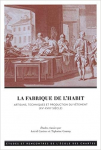| Type de document : | Ouvrage |
| Titre : | La fabrique de l'habit |
| Auteurs : | Astrid CASTRES, Directeur de publication |
| Editeur : | Paris : ECOLE NATIONALE DES CHARTES, 2020 |
| Langues | Français |
| Format : | 228 p. / ill. en noir et en coul. |
| Présentation : | ill. en noir et en coul. |
| ISBN/ISSN/EAN : | 978-2-35723-157-3 |
| Mots-clés : |
Nom Commun 15EME SIECLE ; 16EME SIECLE ; 17EME SIECLE ; 18EME SIECLE ; ARTISANAT METIERS D ART ; COSTUME DE SCENE ; HISTOIRE ; HISTOIRE DE LA MODE ; LEXIQUE ; PATRIMOINE ; PROCEDE DE FABRICATION ; VETEMENT |
| Résumé : |
Au Moyen Age et tout au long de l'époque moderne, le vêtement était un bien coûteux, aux modes d'acquisition et d'entretien spécifiques. Sa production relevait de logiques d'économie du matériau (récupération, piéçage), amenées à évoluer après l'essor de l'industrie textile et de la confection, l'apparition des grands magasins et l'invention de la machine à coudre au XIXe siècle. Chercheurs et spécialistes du vêtement (archéologues, conservatrices-restauratrices du patrimoine, historiens, historiennes de l'art et professionnels du costume de scène) explorent dans ce livre la culture technique des artisans de l'habillement entre le XVe et le XVIIIe siècle. Le dialogue entre les disciplines ici représentées permet d'envisager sous un angle neuf les pratiques professionnelles et les cadres de fabrication des vêtements et des accessoires de mode en Occident dans les sociétés pré-industrielles. Au-delà d'une approche pluridisciplinaire, cet ouvrage soulève des questionnements méthodologiques liés aux recherches sur l'histoire du vêtement, notamment sur la manière de documenter l'histoire de savoir-faire textiles, dont certains relèvent d'un patrimoine immatériel à préserver. (Note de l'éditeur)
In the Middle Ages and throughout modern times, clothing was an expensive commodity, with specific methods of acquisition and maintenance. Its production was based on the logic of material economy (recovery, piecing), which evolved after the boom of the textile and clothing industry, the appearance of department stores and the invention of the sewing machine in the 19th century. In this book, researchers and clothing specialists (archaeologists, heritage conservator-restorers, historians, art historians and stage costume professionals) explore the technical culture of clothing craftsmen between the 15th and 18th centuries. The dialogue between the disciplines represented here allows us to take a fresh look at the professional practices and manufacturing frameworks for clothing and fashion accessories in the West in pre-industrial societies. Beyond a multidisciplinary approach, this book raises methodological questions related to research on the history of clothing, in particular on how to document the history of textile know-how, some of which is part of an intangible heritage to be preserved. (Editor's note) |
Exemplaires (1)
| Cote | Support | Localisation | Section | Disponibilité |
|---|---|---|---|---|
| 0.2 - 8887 | Ouvrage | Bibliothèque IFM | 0.2 Histoire | Disponible |











